This year’s Art Taipei, organized by the Taiwan Art Gallery Association (TAGA), signals that physical fairs—after a bleak, sluggish, and demoralizing period during COVID-19—are truly back in business. Featuring galleries from cities like London, Paris, Prague, New York, Hong Kong, Seoul, Singapore, Kyoto, and Taipei, the contemporary artworks reflected diverse trends, visual languages, and contexts from around the world. Manila-based Ysobel Gallery, the sole Art Taipei representative from the Philippines, presented Filipino contemporary visual artist Sid Natividad’s “Of Ebbs and Echoes,” a solo exhibition featuring photorealistic depictions of a world submerged in water. Another Filipino artist prominently featured this year was contemporary painter Bjorn Calleja. Part of Taiwanese space Lei Xiang Gallery’s roster, Calleja’s visually compelling style and unique approach to figuration were striking in a fair that showcased hundreds, if not thousands, of contemporary pieces. READ: Artist Bjorn Calleja keeps it surreal “Title ng isang trabaho ko ay ‘Dead Weight.’ Naisip ko lang habang nakahiga sa hammock ’yung bigat ko—realization siya, in the sense, na I am my own burden or dead weight… na-relate ko din siya sa mga emotional, spiritual, mental baggage na nararanasan ko at times,” says Calleja. Attended by artists, art collectors, connoisseurs, and enthusiasts from the Asia-Pacific region, Art Taipei 2024 captured a cross-section of emerging regional and global trends in the art world—works that powerfully embody and comment on today’s cultural, political, and ecological realities. Filipino visual artist Ayka Go, Bacolod-based Orange Project exhibition director Candy Nagrampa, and myself flew to Taiwan to experience firsthand what Art Taipei 2024 had to offer. Together, we compiled a list of 12 standout works from the thousands of pieces showcased during Taiwan’s week-long art extravaganza.
Ayka Go’s picks
Nicolas Bertoux’s “Siren’s Nest” presented by Chenhow Marble
 Filipino visual artist Ayka Go states that Nicolas Bertoux’s amazonite piece titled “Siren’s Nest” reminds her of a larger-than-life gemstone
Filipino visual artist Ayka Go states that Nicolas Bertoux’s amazonite piece titled “Siren’s Nest” reminds her of a larger-than-life gemstone
Paris-born Nicolas Bertoux’s gorgeous amazonite sculpture caught my attention for many reasons. First, it is a sculpture that was caressed by countless viewers at Art Taipei. Second, the sculpture’s beautiful biomorphic form had so much quiet elegance to it. Third, its polychromatic material, amazonite, made the sculpture appear like a larger-than-life gemstone or, better yet, a healing stone. Nicolas Bertoux’s amazonite masterpiece “Siren’s Nest” is a piece wherein three continents meet: a stunning material from South America sculpted by an artist from Europe and commissioned by a gallery based in Asia. In a rather poetic way, “Siren’s Nest” is a piece that shows the beautiful interconnectedness of humanity.
Li Chen’s “Dragon-Riding Buddha” presented by Art Asia Center
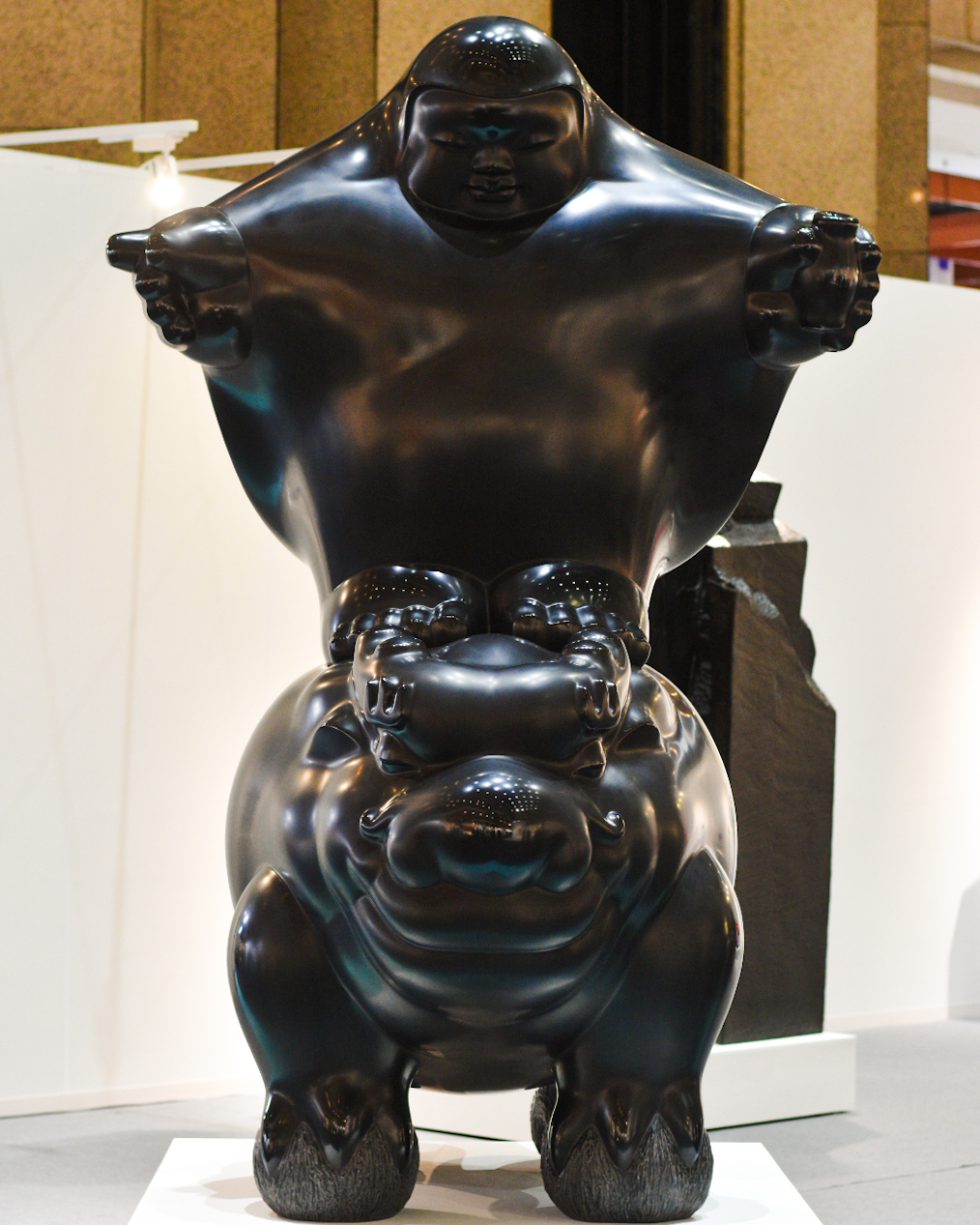 Li Chen’s Dragon-Riding Buddha presented by Art Asia Center
Li Chen’s Dragon-Riding Buddha presented by Art Asia Center
Art fairs can be overly stimulating. When I went around to check the works at Art Taipei 2024, a specific work spoke to me because of its scale and playful style of figuration. An imposing sculpture of a Buddha riding a dragon stood as a central figure at Art Taipei. Produced by Li Chen, a sculptor who initially sculpted classical and traditional Buddha figures before reimagining the image of the Buddha using his childlike style and visual language, his Art Taipei piece “Dragon-Riding Buddha” is a contemporary take on a deeply revered figure. An achromatic work that shows the Buddha in a stance and style unlike anything we see in more traditional representations, Li Chen’s work commanded attention.
Jiang Miao’s dazzling subtractive paintings at Modern Art Gallery
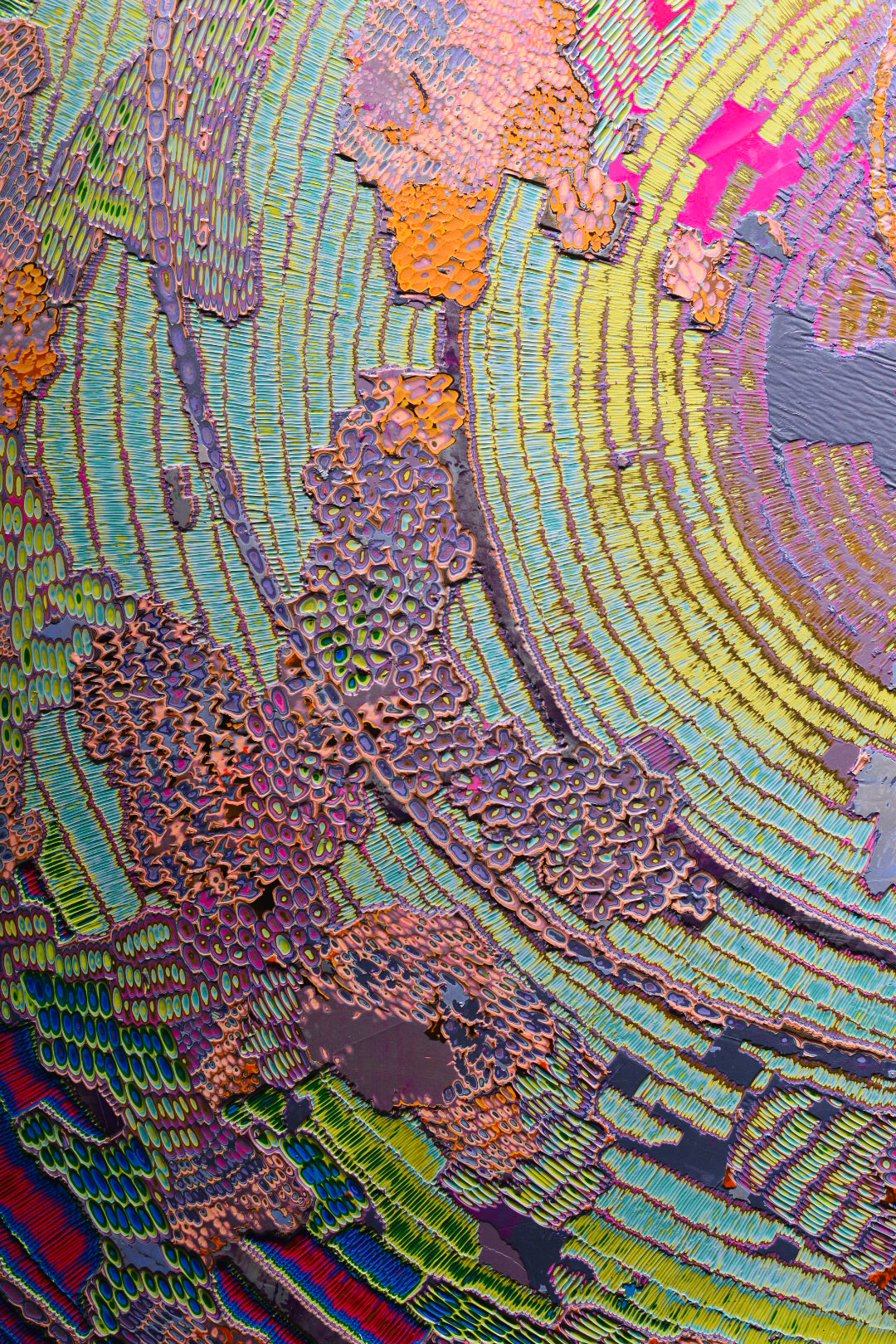 Jiang Miao’s dazzling subtractive paintings at Modern Art Gallery
Jiang Miao’s dazzling subtractive paintings at Modern Art Gallery
The subtractive process applied in this work is simply captivating. There is absolutely no muddiness in terms of color mixing. Each layer possesses a completely different hue that is beautifully revealed by Jiang Miao’s meticulous subtractive process—perhaps by carving or chiseling or hammering. The surface of the piece suggests a kind of restrained violence as it reveals multiple layers of paint all at once—each layer like an exposed membrane or epidermis of a complex, polychromatic skin.
Kurumi Kotani’s “Tulip” at Guan Zhi Tang Admira
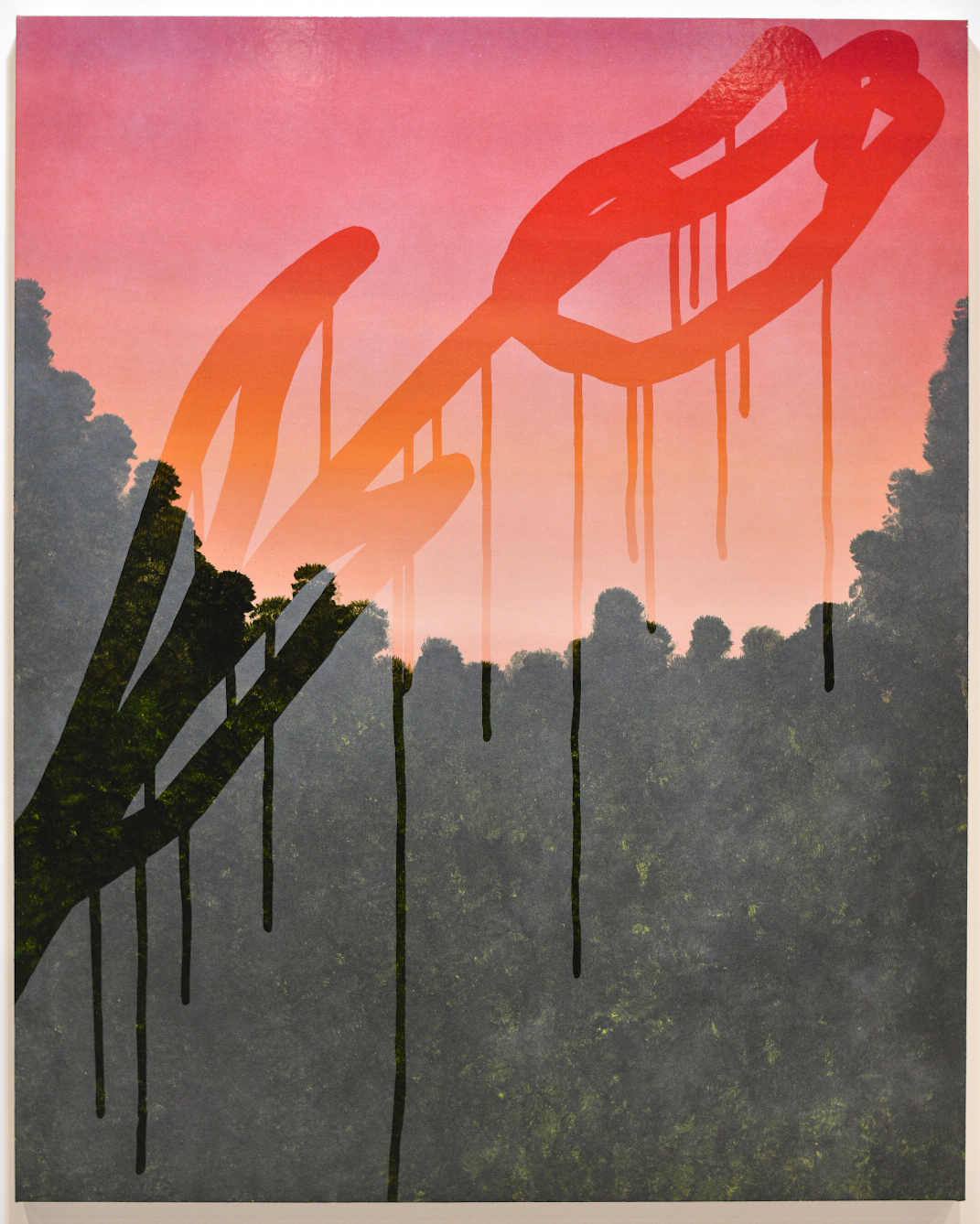 Kurumi Kotani’s Tulip at Guan Zhi Tang Admira
Kurumi Kotani’s Tulip at Guan Zhi Tang Admira
The contrast between the frosted sections of the painting and the crystal clear gestural figure produced an eye-catching composition of a landscape that is reminiscent of a frosted window splattered with water. Look closely and you will see a schematic image of a tulip against a frosted backdrop. Like Kotani’s piece, I can imagine sliding my finger through a frosted glass window and drawing whimsical figures lifted from my childhood memories.
READ: The legacy and origin story of artist Justin Nuyda
Candy Nagrampa’s picks
Sid Natividad’s solo show “Of Ebbs and Echoes” presented by Ysobel Gallery
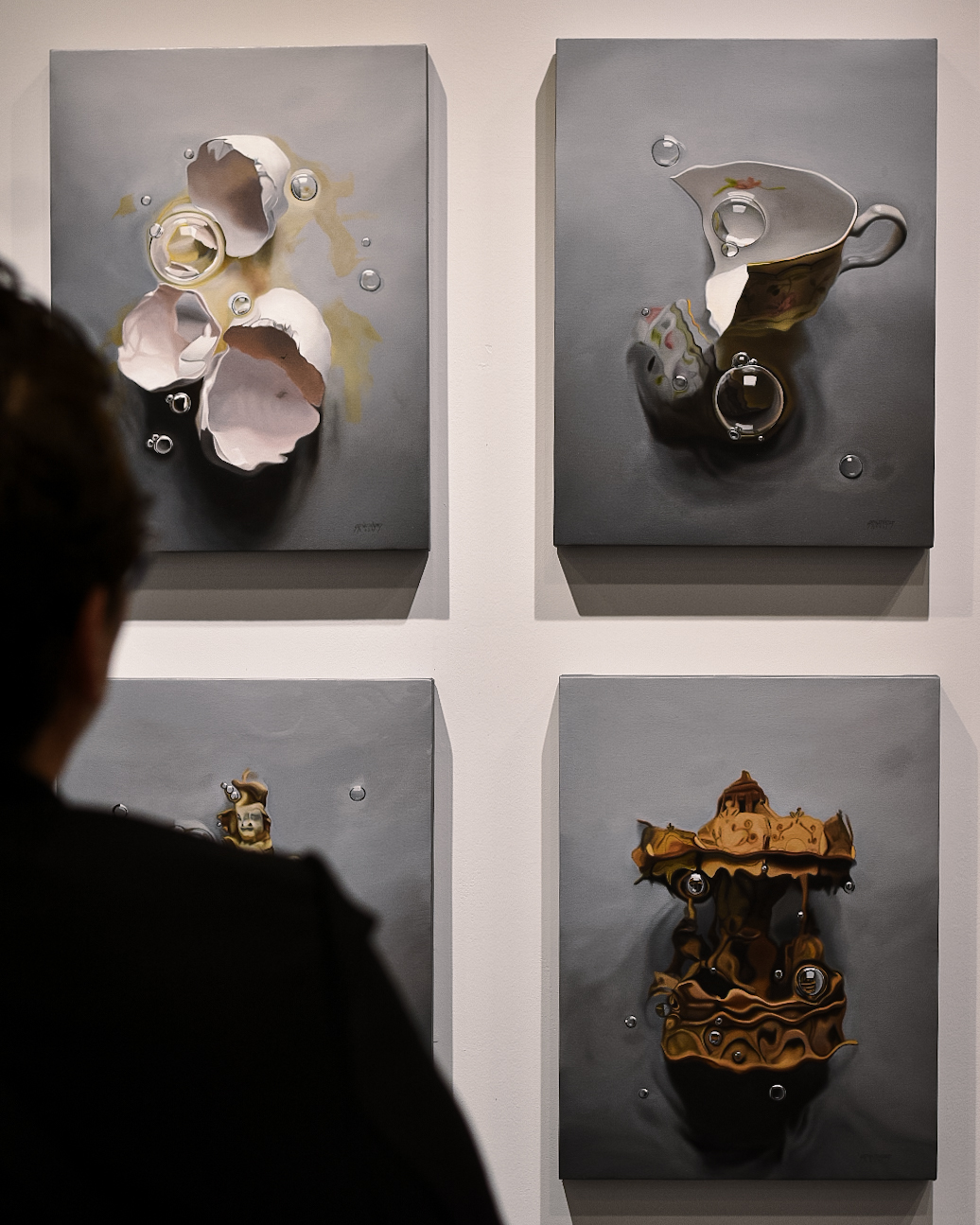 Pieces from Sid Natividad’s “Of Ebbs and Echoes” solo exhibition presented by Ysobel Gallery at Art Taipei 2024
Pieces from Sid Natividad’s “Of Ebbs and Echoes” solo exhibition presented by Ysobel Gallery at Art Taipei 2024
I first saw Sid’s work in Ysobel’s booth at Art Fair Philippines 2019. I could not breathe. You see, as a child, I had a traumatic experience of almost drowning. Eventually, I learned how to swim. When I saw his work again in the recently concluded Art Taipei, I was reunited with my younger self. I was drawn to a painting of a musical carousel that is submerged in water. The image is charged with both a sense of comfort and melancholy. Sid Natividad’s poetic depiction of water made me imagine hearing the sound of bubbles while helplessly watching a toy carousel sink into the ocean’s abyss. Somehow, this imagery gave me a sense of peace.
Kiko Miyares‘ pine wood figures at Dopeness Art Lab
 Kiko Miyares’ pine wood figures at Dopeness Art Lab
Kiko Miyares’ pine wood figures at Dopeness Art Lab
Kiko Miyares’ work “Cuida Tu Fantasma (Take care of your ghosts)” are haunting pine wood figures that reminded me of our political and social injustices. Seeing the figures before even reading the title sparked memories of extrajudicial killings or EJK during the term of the former president Duterte. When I read the title of Miyares’ figures, the aptness of it struck me even more. For me, all the innocent lives lost by EJK are like walking ghosts that are forever seeking justice.
Aluaiy Kaunakan’s fiber art installation presented by Liang Gallery
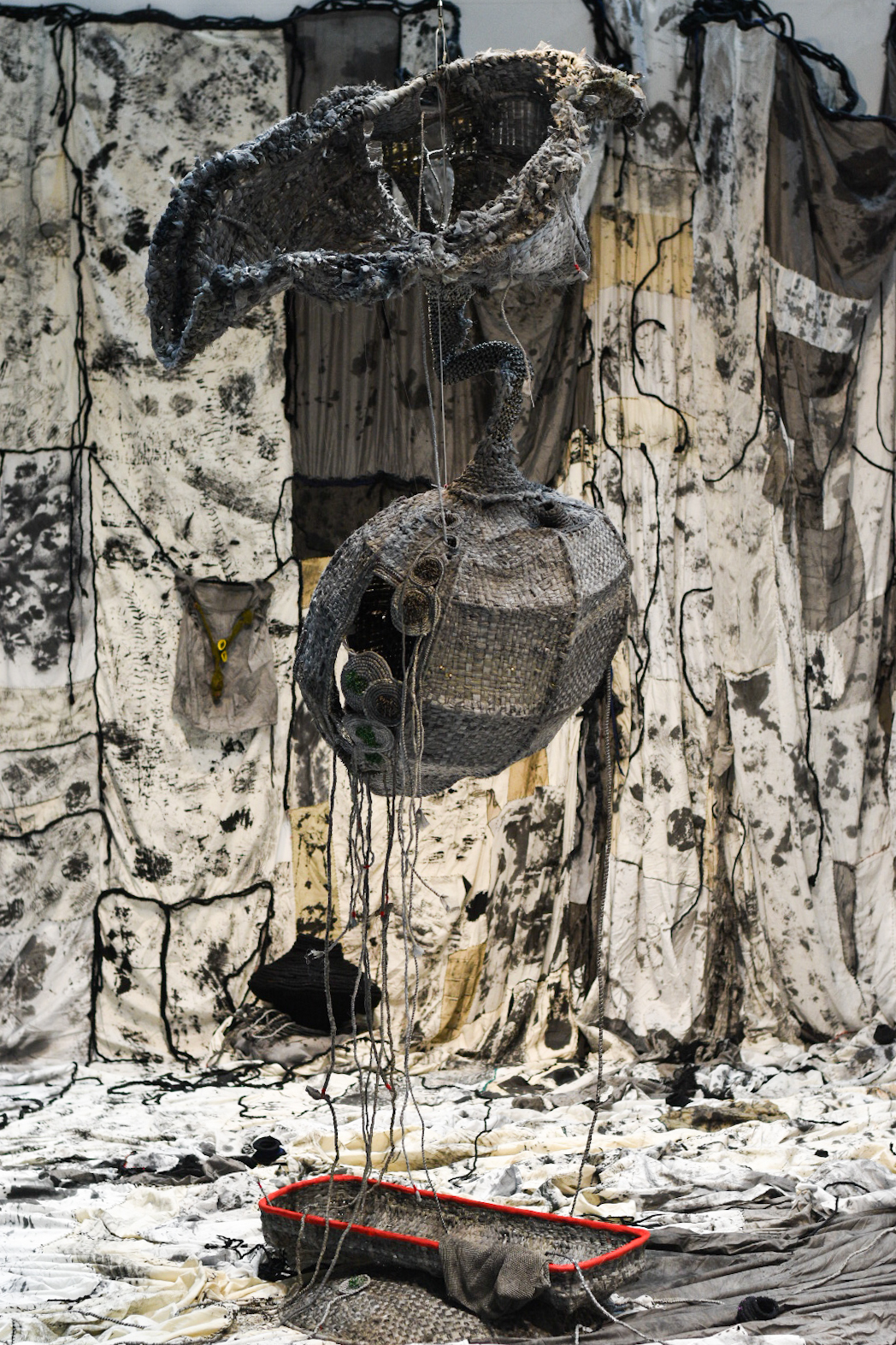 Aluaiy Kaunakan’s fiber art installation presented by Liang Gallery
Aluaiy Kaunakan’s fiber art installation presented by Liang Gallery
The layers and odd shapes of Aluaiy Kaunakan’s installation piece—textiles, paints, found objects, and choice of color—caught my attention. It’s like watching a meditative movement of unified yet obscure motions. And it’s the obscureness of it all that I liked the most.
Julien Tang’s ceramic figures presented by J.P. Art Center
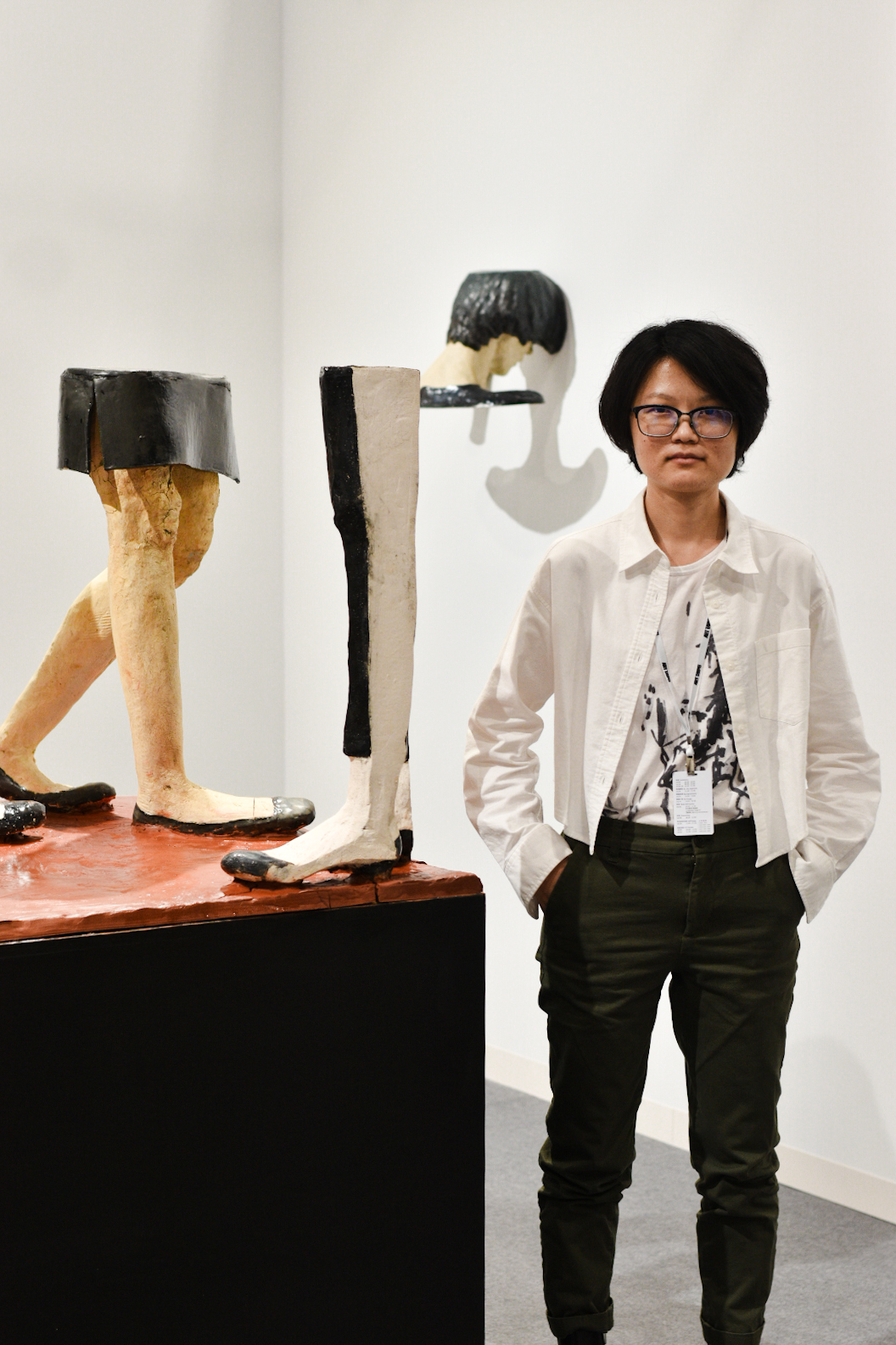 Julien Tang with her ceramic sculptures at Art Taipei 2024
Julien Tang with her ceramic sculptures at Art Taipei 2024
Julien Tang’s ceramic works appealed to the part of me that loves cinema. Walking inside her solo exhibition was like entering a film—her works and the curatorial design of her exhibition mirrored the cinematic experience. And when I saw her video work, I was reminded of my past work as an assistant director for films. I felt a sense of belongingness and familiarity with Tang’s works.
Patrick de Veyra’s picks
Keiichi Tanaami’s “Invisible Being” presented by Nanzuka
 Keiichi Tanaami’s “Invisible Being” presented by Nanzuka
Keiichi Tanaami’s “Invisible Being” presented by Nanzuka
Seeing a painting by the late Keiichi Tanaami at Art Taipei 2024 was one of the biggest surprises of the five-day fair. As a visual artist, I found much inspiration in Tanaami’s visual language and aesthetic sensibility. His provocative, visually rich, and compositionally dynamic works demand attention. Although his pictorial fields appear otherworldly and surreal, Tanaami stated that his works were based on his personal experiences, meetings, and key life events. His piece “Invisible Being” is a visual feast marked by a distinct energy and rhythm. The psychedelia, the kitschiness, the boldness—everything!
Bjorn Calleja’s “Dead Weight” presented by Lei Xiang Gallery
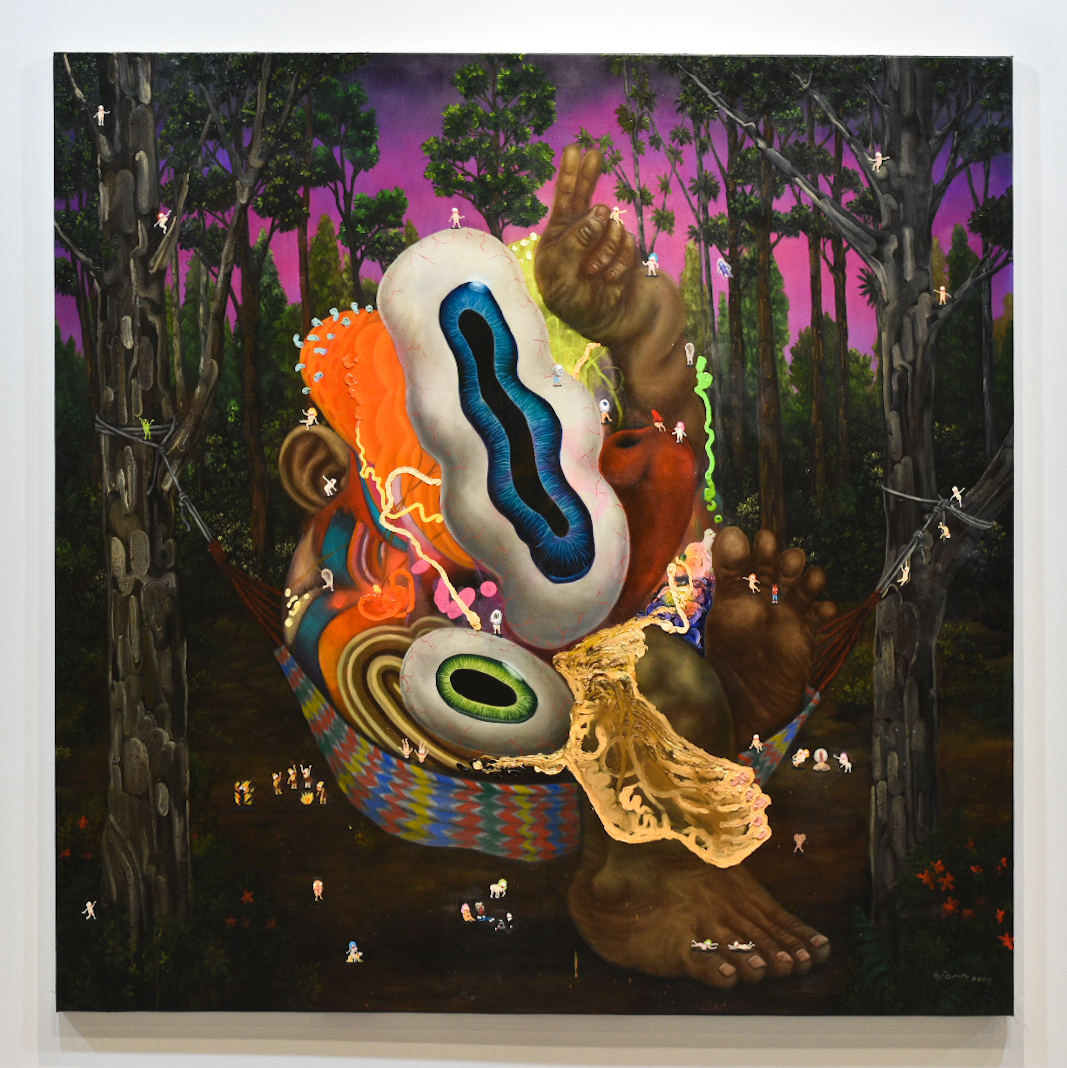 Bjorn Calleja’s “Dead Weight” presented by Lei Xiang Gallery
Bjorn Calleja’s “Dead Weight” presented by Lei Xiang Gallery
Filipino visual artist Bjorn Calleja’s work “Dead Weight” is the culmination of his series of paintings that reference iconic works in Western art history. Here, Calleja explores the concept of being one’s own burden, touching on emotional, spiritual, and psychological themes. In a recent conversation, he shared that his impetus for “Dead Weight” stems from both the physical sensation of heaviness and the overwhelming weight on his psyche. His depiction of the inextricable relationship between what is physical and what is psychological is something that I deeply resonate with.
Japanese contemporary artist collective three’s “3017g” presented by Whitestone Gallery
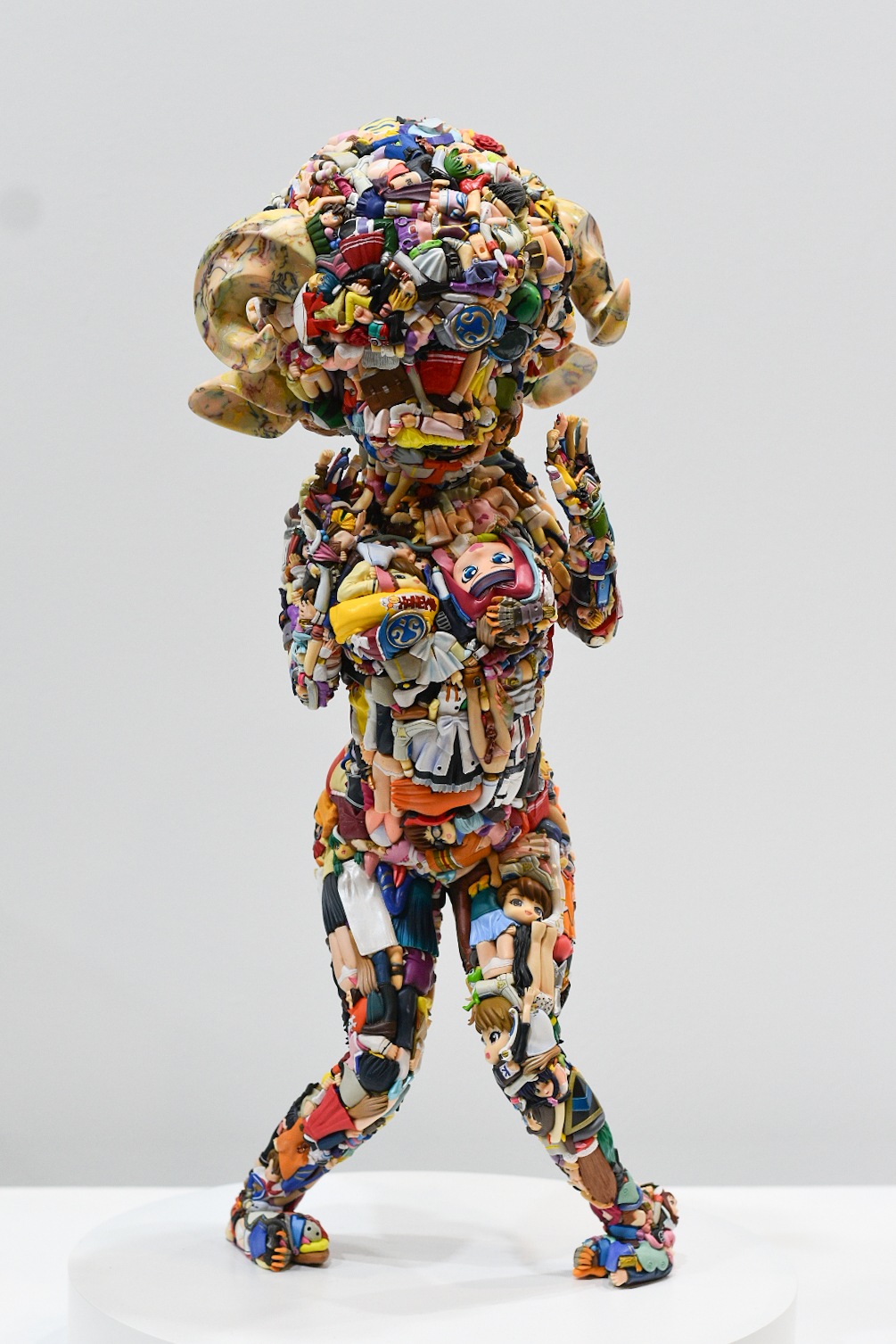 Japanese contemporary artist collective three’s 3017g presented by Whitestone Gallery
Japanese contemporary artist collective three’s 3017g presented by Whitestone Gallery
The process of breaking down, fragmenting, and reassembling that defines the body of work of the Japanese contemporary artist collective ‘three’ is something that commands attention. The collective’s dynamic and edgy visual language addresses themes of consumerism, mass production, contemporary myth-making, and identity within the context of otaku culture. The collective’s piece “3017g” is a visually compelling work that establishes relationships between the sculpture’s appropriated constituent parts and the resulting composite figure.
Mariko Mori’s “Unity” and “Wave UFO Model II” presented by SCAI the Bathhouse
 Mariko Mori’s “Unity” and “Wave UFO Model II” presented by SCAI the Bathhouse
Mariko Mori’s “Unity” and “Wave UFO Model II” presented by SCAI the Bathhouse
Not unlike her seminal works from the ’90s to the present day, Mariko Mori’s pieces presented by SCAI the Bathhouse at Art Taipei 2024 continue to explore themes of spirituality, otherness, fantasy, and the cosmos. The subtle beauty and otherworldly character of Mori’s works stand out in a sea of contemporary artworks. I have long been fascinated by her fantastical body of work, as it is charged with universal themes that connect with the larger human experience.
Photos by Patrick de Veyra
READ: ‘In Situslot paraiso, Performance as Exhibition’ brings global performance art to PH